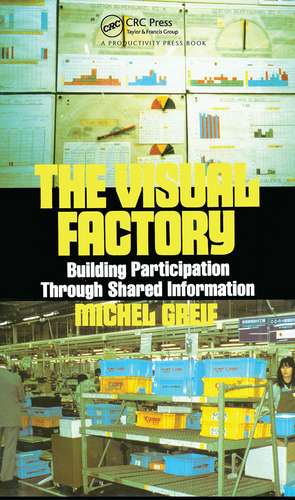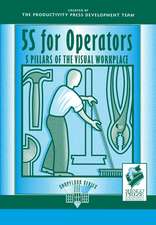The Visual Factory: Building Participation Through Shared Information
Autor Michel Greifen Limba Engleză Hardback – feb 1991
- Foster cohesion within groups of employees.
- Turn fault-based into fact based communication.
- Overcome such problems as absenteeism and high defect rates.
- Stimulate an unending flow of suggestions from employees.
Preț: 546.00 lei
Preț vechi: 642.36 lei
-15% Nou
Puncte Express: 819
Preț estimativ în valută:
104.56€ • 106.70$ • 87.97£
104.56€ • 106.70$ • 87.97£
Carte tipărită la comandă
Livrare economică 26 februarie-12 martie
Preluare comenzi: 021 569.72.76
Specificații
ISBN-13: 9780915299676
ISBN-10: 0915299674
Pagini: 306
Ilustrații: illustrations
Dimensiuni: 152 x 229 x 27 mm
Greutate: 0.73 kg
Ediția:New.
Editura: Taylor & Francis
Colecția Productivity Press
Locul publicării:Oxford, United Kingdom
ISBN-10: 0915299674
Pagini: 306
Ilustrații: illustrations
Dimensiuni: 152 x 229 x 27 mm
Greutate: 0.73 kg
Ediția:New.
Editura: Taylor & Francis
Colecția Productivity Press
Locul publicării:Oxford, United Kingdom
Public țintă
Professional and Professional Practice & DevelopmentRecenzii
"Does an excellent job of introducing the concepts of visual factories as well as providing a guideline for implementing them."
Dan Blount, Engineering Manager, Hewlett Packard 06/01/04
Dan Blount, Engineering Manager, Hewlett Packard 06/01/04
Cuprins
1: The Renaissance: Platonism; 2: Cultura Hominis: Giovanni Pico, Marsilio Ficino and the Idea of Man; 3: Renaissance Neoplatonism [and Literary Criticism]; 4: Marsilio Ficino: Daemonic Mathematics and the Hypotenuse of the Spirit; 5: In principio: Marsilio Ficino on the Life of Text; 6: The Ficinian Timaeus and Renaissance Science; 7: Paul Oskar Kristeller and Marsilio Ficino: Etenebris Revocaverunt; 8: Marsilio Ficino, Levitation, and the Ascent to Capricorn; 9: Marsilio Ficino and the Language of the Past; 10: The Birth Day of Venus; 11: «Quisque in Sphaera Sua»: Plato’s Statesman, Marsilio Ficino’s Platonic Theology, and the Resurrection of the Body; 12: At Variance: Marsilio Ficino, Platonism and Heresy; 13: Sending Archedemus: Ficino, Plato’s Second Letter, and its Four Epistolary Mysteries; 14: To Gaze Upon the Face of God Again: Philosophic Statuary, Pygmalion and Marsilio Ficino; 15: Marsilio Ficino on Saturn, the Plotinian Mind, and the Monster of Averroes; 16: Eurydice in Hades: Florentine Platonism and an Orphic Mystery; 17: Prometheus Among the Florentines: Marsilio Ficino on the Myth of Triadic Power; 18: Ratio Omnium Divinissima: Plato’s Epinomis, Prophecy, and Marsilio Ficino; Corrigenda & Addenda
Descriere
With more than 200 diagarms and photos illustrating visual techniques, this book explains why conventional work areas, where fragmented information flows from "top to bottom," must be replaced by the "visual workplace," where information flows in every direction. It details how visual management can make the factory a place where workers and supervisors freely communicate so that every employee can take improvement action. The author explores techniques for fostering cohesion within work groups, clear communication, absenteeism reduction, and employee feedback.


















